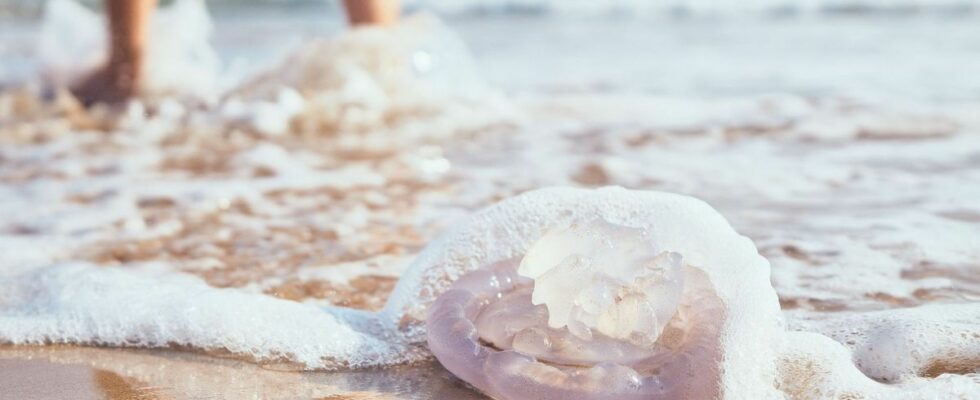Published on
Updated
Reading 2 min.
in collaboration with
Dr. Gérald Kierzek (Medical Director)
Present on dozens of beaches in the south of France, jellyfish can make your vacation a little more… irritating, shall we say. How to react in the event of a sting? Dr. Gérald Kierzek reminds us of the right actions.
They are also part of the holiday! Jellyfish have been spotted since the end of spring and are currently being spotted on dozens of beaches, particularly in the South-East, around the Mediterranean.
Where are the jellyfish now and why?
Since the beginning of July, jellyfish have been numerous on the Côte d’Azur, particularly in Nice, Antibes, Toulon, Marseille, but also Roquebrune and Juan-les-Pins. Corsica has also been affected. For the time being, however, the Atlantic coast seems to have been spared, as shown by the map provided by the Acrian office specializing in the processing of satellite data
The arrival of jellyfish is not a big surprise: the date of arrival of jellyfish on our beaches seems to be getting earlier every year. This is partly due to global warming: the rise in water temperatures leads to early sexual maturity in jellyfish and therefore a faster reproduction rate. Global warming also drives away their predators while promoting the plankton that they feast on. In short, everything is in place to be able to share the beach with them.
The problem with these pests is that they are irritating and can quickly ruin your vacation if you come into contact with them.
The jellyfish has stinging cells on its tentacles, which in case of contact with the skin cause a stinging sensation. In this case the inflammatory reaction is often immediate and symptoms occur:
A red mark several centimeters long on the area of the sting, as well as vesicles similar to nettle stings also appear.
In the event of a sting, it is therefore necessary to react quickly. But contrary to popular belief, it is not enough to pee on the wound, as Dr. Gérald Kierzek points out,
“This does not in any way relieve the pain associated with the jellyfish venom. The idea behind this “seaside legend” was not so much to pee on it but rather to relieve the pain through the temperature of the urine. It was a matter of bringing a source of heat close to the sting. But this does not work. The toxin in the venom is not heat labile. It is not necessarily destroyed by the heat of the urine.”
This misconception can even be counterproductive, as it can cause the remaining cells of the tentacles to burst, releasing the venom and therefore increasing the pain.
What is the correct reaction then?You should rinse the area with salt water (sea water) and not fresh water. You can also apply sand to the bite and scrape it with a credit card or postcard to remove any remaining tentacles. Do not remove them with your fingers.adds the expert.
If the pain persists after 48 hours, contact your doctor.
